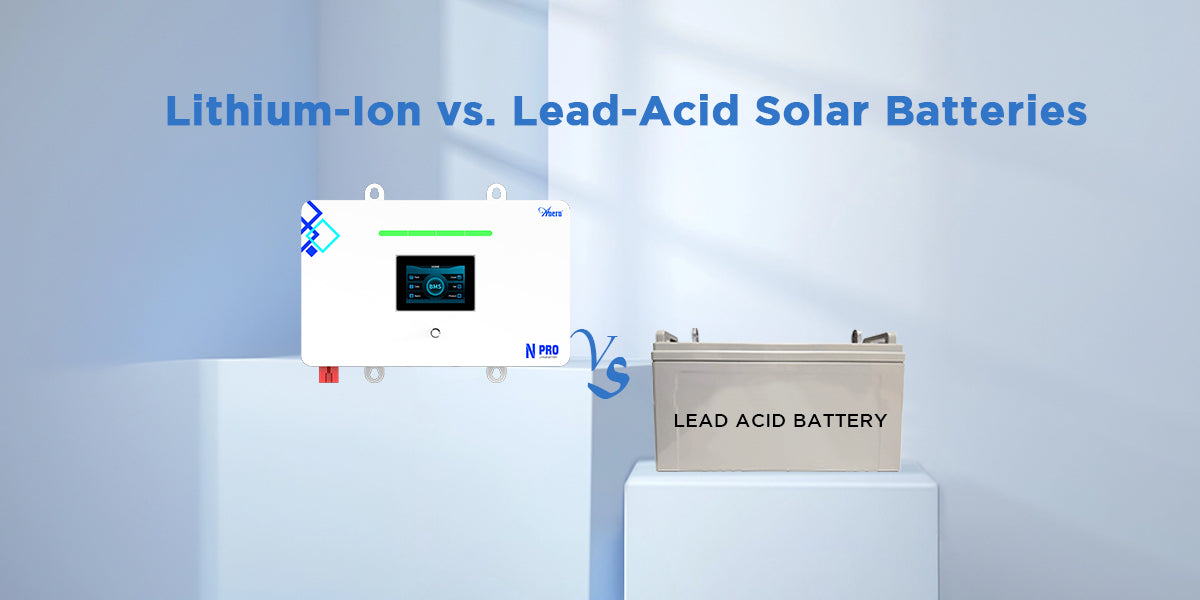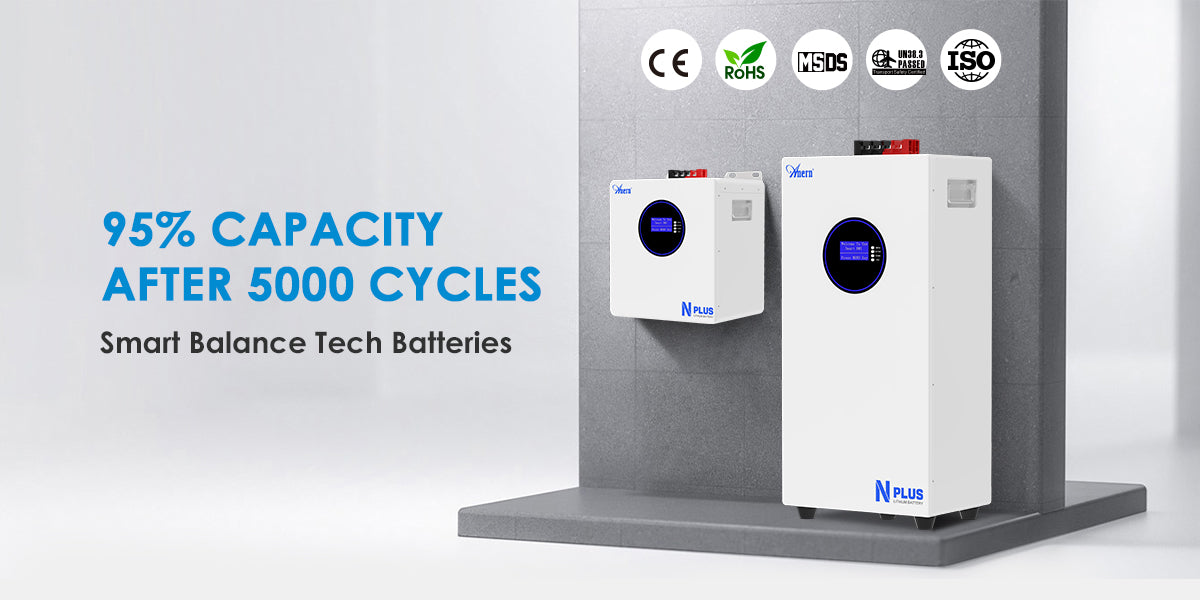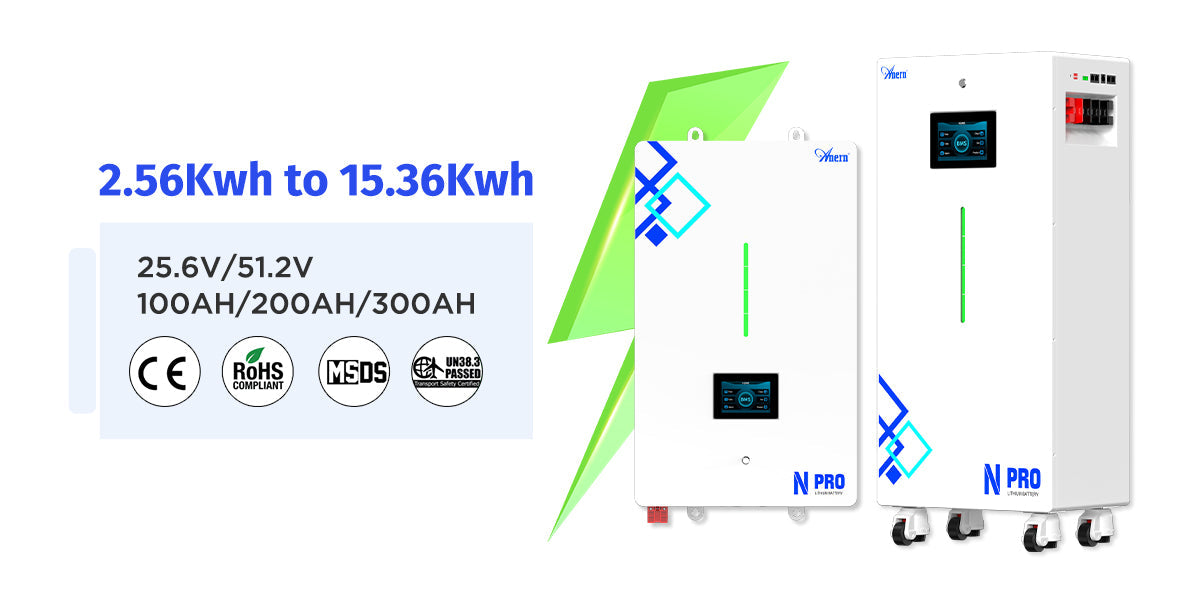Solar batteries help store power for homes, cabins, and even RVs. Two of the most common types are lithium-ion and lead-acid. They both store solar energy, but they work in very different ways. Before buying a battery, it's smart to look at how they compare in terms of life, weight, safety, cost, and more.
Battery Lifespan
Battery lifespan means how many years or charging cycles it can last. One cycle means using the battery from full to empty and then charging it again.
Lithium-ion solar batteries usually last longer than lead-acid ones. Most lithium batteries can handle 3,000 to 6,000 cycles. That means 10 to 15 years of use. They can handle deeper discharges without damage.
Lead-acid batteries often last only 500 to 1,000 cycles. That equals around 3 to 5 years. If you drain them too much, they wear out even faster.
A Quick Look at the Lifespan of Lithium-Ion vs. Lead-Acid Solar Batteries
| Feature | Lithium-Ion | Lead-Acid |
| Cycle Life | 3,000 to 6,000 cycles | 500 to 1,000 cycles |
| Years of Use | 10 to 15 years | 3 to 5 years |
| Deep Discharge | Safe | Shortens life |
Safe Storage
Safety is important, especially in homes with kids or pets.
Lithium-ion batteries use smart systems called Battery Management Systems (BMS). These protect from overcharging, overheating, and short circuits. While rare, if damaged, lithium cells can heat up quickly. So, a well-built lithium battery must include a strong BMS.
Lead-acid batteries are very stable. They do not need electronics to stay safe. But they can leak acid or give off gas. That means they need good airflow and must not tip over.

Safety of Lithium-Ion vs. Lead-Acid Solar Batteries
| Feature | Lithium-Ion | Lead-Acid |
| Thermal Risk | Low (with BMS) | Very low |
| Gas Emission | None | Yes, during charging |
| Leak Risk | No | Yes (acid) |
| Safe Orientation | Any direction | Upright only |
Efficiency and Performance Compared
Efficiency shows how well the battery uses energy. High efficiency means less loss.
Lithium-ion solar batteries are highly efficient. About 90 to 95% of the energy goes in and comes back out. They also charge faster.
Lead-acid batteries have lower efficiency. They lose more energy during charging and discharging. Most offer only 70 to 85% efficiency.
Efficiency of Lithium-Ion vs. Lead-Acid Solar Batteries
| Feature | Lithium-Ion | Lead-Acid |
| Round-Trip Efficiency | 90% to 95% | 70% to 85% |
| Charge Speed | Fast | Slower |
| Energy Loss | Low | High |
Cost Comparison Over Time
Cost matters, but not just at the start. It is helpful to look at long-term value.
Lithium-ion batteries cost more upfront. But they last longer and need no maintenance. Over 10 years, they may cost less per cycle.
Lead-acid batteries are cheaper to buy. But they wear out faster and often need replacing in just a few years.
Cost of Lithium-Ion vs. Lead-Acid Solar Batteries
| Feature | Lithium-Ion | Lead-Acid |
| Initial Cost | High | Low |
| Long-Term Cost | Low per cycle | High per cycle |
| Replacement Rate | Rare (10+ years) | Frequent (3–5 years) |
Installation Differences
Installing a solar battery should be easy and safe.
Lithium-ion batteries are easier to install. They are smaller, lighter, and do not need airflow. Many can be mounted on walls or placed in closets.
Lead-acid batteries need more planning. They require open airflow to release gas. They cannot be placed in sealed boxes or small rooms.
Installation of Lithium-Ion vs. Lead-Acid Solar Batteries
| Feature | Lithium-Ion | Lead-Acid |
| Air Ventilation | Not needed | Required |
| Placement Options | Flexible | Limited |
| Wall Mount Possible | Yes | No |
Care or No Care: Maintenance Needs
Ongoing care can be a burden or a breeze.
Lithium-ion solar batteries are maintenance-free. They do not need water checks or terminal cleaning. You can forget about them after installation.
Lead-acid batteries need regular checks. You must check water levels, clean terminals, and avoid full discharges.
Maintenance of Lithium-Ion vs. Lead-Acid Solar Batteries
| Feature | Lithium-Ion | Lead-Acid |
| Water Refill Needed | No | Yes |
| Terminal Cleaning | No | Yes |
| Monitoring Needed | Minimal | Frequent |
Choosing Smart: Why Lithium-Ion Is Often the Better Fit
Most homes today prefer lithium-ion solar batteries. They are easier to install, last longer, and use less energy. Over time, they may save more money even though the first cost is higher.
If you have a small space, need quiet power, or want little maintenance, lithium is a great fit.
That said, lead-acid batteries still have a place. They are useful for short-term setups, off-grid cabins, or limited budgets. If you only use solar backup once in a while, lead-acid may be enough.
Think about your space, your budget, and how often you use solar power. Then match the battery to your real needs.
If you want a long life, fewer hassles, and better performance, a lithium-ion solar battery is the smarter choice for most people.
FAQs
Q1: Can I mix lithium-ion and lead-acid batteries in the same solar system?
A: No. Mixing lithium-ion and lead-acid batteries in one system is not recommended. They have different charging needs, voltage behavior, and discharge patterns. Using both together can lead to battery damage, fire risk, or inverter malfunction. Always use the same type and brand of batteries in one bank.
Q2: What happens to solar batteries during a power outage?
A: If your system includes a solar battery with proper backup wiring, your home can stay powered during a blackout. The battery stores energy from your panels and automatically switches on when the grid shuts down. Some setups also allow daytime charging during outages, but that depends on the inverter type.
Q3: Do lithium-ion solar batteries need to be heated in winter?
A: Not heated, but they do need to stay warm. When the temperature drops below 32°F (0°C), lithium-ion batteries can lose power and hold less charge. In very cold places, the battery might not work well or charge fully. It’s best to install the battery indoors or in a place that stays warm, like a garage or insulated box.
Q4: How can I recycle old solar batteries safely?
A: Lead-acid batteries are widely recycled and accepted at auto shops and recycling centers. Lithium-ion batteries require special handling. Contact your local hazardous waste facility or battery recycling program. Never throw solar batteries into regular trash—they can leak or catch fire in landfills.
Q5: Is it possible to monitor solar battery performance remotely?
A: Yes. Most lithium-ion solar batteries now offer smart monitoring through mobile apps or web dashboards. You can track charge level, energy use, temperature, and performance over time. Lead-acid systems usually lack this feature unless paired with advanced third-party monitoring hardware.





Leave a comment
All comments are moderated before being published.
This site is protected by hCaptcha and the hCaptcha Privacy Policy and Terms of Service apply.